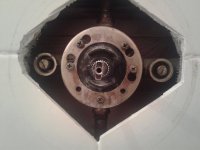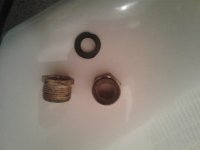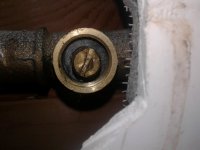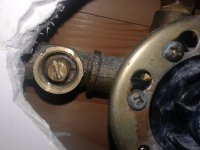GLMhelpfix
New Member
Hello all,
Just finished a new water heater install for my girlfriend's folks, and the already poor hot water pressure in one of their tub/showers dipped even more to make it near unusable. Rest of the hot water throughout the house is fine, this bathroom is midway through the line, sink in the same bathroom is great.
I opened up the mixer valve, checked the cartridge which is fine, and ran the water without the cartridge in to verify the pressure was bad at the supply, which it was (less than half of the cold, and it's about equal in the rest of the house).
There are what look like flathead shut off valves on either supply, but I can't get either of them to move even a little bit (photo below):

The shut off's had these fittings threaded in with washers behind them:

And behind those was some kind of black compound set in:

Which I carved out on the hotline to see if that freed up the valve at all, which it didn't:

I can't tell if the valve stem is supposed to rotate inside that fitting, or if it's supposed to rotate in the threads? I can't get even a slight budge out of it, and don't want to reef on it any harder until I have another rough valve body ready in case things go awry and I'm not leaving the whole house without water. I've already tried cranking on it pretty good with a pair of channel locks. The whole setup of it has me stumped, but my suspicion is that the hot valve isn't opened all the way or that's were the obstruction is lodged.
Would really appreciate any advice/points in the right direction, thanks much!
Just finished a new water heater install for my girlfriend's folks, and the already poor hot water pressure in one of their tub/showers dipped even more to make it near unusable. Rest of the hot water throughout the house is fine, this bathroom is midway through the line, sink in the same bathroom is great.
I opened up the mixer valve, checked the cartridge which is fine, and ran the water without the cartridge in to verify the pressure was bad at the supply, which it was (less than half of the cold, and it's about equal in the rest of the house).
There are what look like flathead shut off valves on either supply, but I can't get either of them to move even a little bit (photo below):

The shut off's had these fittings threaded in with washers behind them:

And behind those was some kind of black compound set in:

Which I carved out on the hotline to see if that freed up the valve at all, which it didn't:

I can't tell if the valve stem is supposed to rotate inside that fitting, or if it's supposed to rotate in the threads? I can't get even a slight budge out of it, and don't want to reef on it any harder until I have another rough valve body ready in case things go awry and I'm not leaving the whole house without water. I've already tried cranking on it pretty good with a pair of channel locks. The whole setup of it has me stumped, but my suspicion is that the hot valve isn't opened all the way or that's were the obstruction is lodged.
Would really appreciate any advice/points in the right direction, thanks much!
